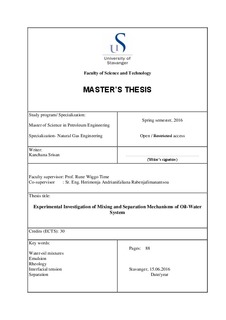| dc.description.abstract | The behaviour of oil-water mixtures/emulsions is of great importance for a variety of industries and sciences. Specially in oil and gas industry, it can be encountered at different stages while drilling, production, storage, transportation and processing of crude oil. The purpose of this thesis is to improve the understanding of oil-water mixtures/emulsions through laboratory experiments. Two mineral oils Bayol 35 and Exxsol D60 and tap water were used as the test materials. Oil - water samples were prepared with varying proportion of oil and water ranging from 5% to 95%. The mixing experiments were conducted in two modes; Hand shaking and mechanical mixing. Under the mechanical mixing mode, the oil-water mixtures were prepared at different mixing speeds (400rpm, 1000rpm, and 1600rpm) and mixing times (1minute and 5minutes). The separation phenomena was studied as a function of the type of oil, mixing duration, mixing speed and adding of colouring agent (Sudan blue and Uranine). The rheology, surface/interfacial tension and density of the oil water mixtures were examined for better understanding of the influence of physical properties on oil-water mixing and separation phenomena. Microscopic pictures were taken to study the separation phenomena, droplet sizes and their distribution.
The results showed that Exxsol D60 oil-water mixtures produce smaller water droplets in oil than Bayol 35 oil-water mixtures, but still Exxsol D60 separates faster explaining that the less viscosity of Exxsol D60 oil phase has a major influence over the droplet size in separation process. Longer mixing time and higher mixing speed lead to higher stability of the emulsions. This is due to the increased energy transferred for the break-up process which eventually lead to small droplets and more stable emulsions. Adding colouring agents modified the interfacial tension so that Sudan blue increased it and Uranine decreased the interfacial tension. This resulted that Sudan blue added oil-water mixtures gave bigger droplets and achieved faster separation in comparison to the Uranine added oil-water mixtures. Pure mineral oil showed Newtonian behaviour while it behaved non-Newtonian for oil-water mixtures.
It was a significant observation to see that always the water droplets were bigger than the oil droplets in all the oil-water mixtures regardless of the type of oil, composition or method of preparation. Further investigations to be carried out to make sure whether this is a phenomena related to the physical properties of oil, physico-chemical properties of oil-water emulsions such as Gibbs free energy or thermodynamics of emulsion formation and break down. | nb_NO |
